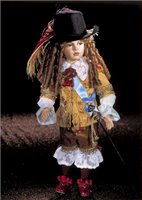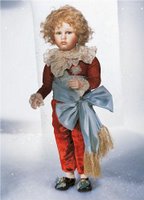
I have Ebay alerts that inform me anytime a doll comes up for bid that refers to King Louis. The day I received an alert about a Mundia doll of Louis XIV as a child I was thrilled. His costume was highly detailed and you could easily see the flamboyant future King in his delicate porcelain face. Best of all, I was able to add him to my collection for less than $75 thanks to a winning bid on Ebay.
Louis's costume includes little heeled shoes embellished with lavish bows. This 18th century shoe style was a departure from the previous male fashion of wearing a boot. A poem in a 1760s fashion catalog sums up the new style:
"Heels to bear the precious charge
More diminutive than large
Slight and brittle, apt to break
Of the true Italian make."
He also wears a high-crowned beaver hat that was gaining in popularity at the time over the longtime three-cornered tricorne hat, swathed with a rakish ostrich plume. His costume is further accented by a dramatic abundance of lace.
"Lace enjoyed a popularity in the Rococo period unprecedented in history. Where the wearing of lace during the 17th Century was restricted by law to the nobility, and during the 19th Century, by custom, to women, its use knew no such bounds during most of the 18th Century. Anyone who could possibly afford to, wore lace as a status symbol. The more money, the more lace.
"Alencon" lace was considered the most elegant and aristocratic, due to its rarity and high cost. Brussels, Mechlin and Binche laces were very popular until the 1750’s when they were eclipsed by Valenciennes lace and Blonde lace." -
The Costumer's Manifesto
I searched the web for more Mundia historical dolls and found that they also produced a doll of Louis XVII - the son of Louis XVI and Marie Antoinette who was wrenched from his doomed mother on July 3, 1793 and is said to have died in the Temple prison on June 8, 1795 of tuberculosis. However, like the report of Anastasia's death a little over a century later, this report was viewed with doubt, especially by monarchists who wished to believe the Bourbon dynasty did not die with him.
"At first, it was widely believed both in France and Britain that the Committee of Public Safety (the radical governing body of the revolution) had murdered the child. Later public opinion came to favor the escape theory. In 1814 the historian of the newly restored French monarchy announced that Louis Charles had escaped and was still alive. He would not reveal his location however. The most common rumor was that royalists substituted another child in his place and spirited him to America where he would be safe.
The rumors did not fade with the passage of time. In 1846 authorities exhumed the mass grave where the child was buried. Only one showed evidence of tuberculosis. But he wasn't a perfect fit. The body appeared to be that of a slightly older child, in his middle to late teens. Of particular interest was the fact that the boy had already cut a wisdom tooth. In the years that followed, at least a hundred men claimed to be the ill-fated prince.
The most intriguing candidate was famous naturalist John James Audubon. Although he never publicly claimed it himself, Audubon was thought by many to be the real Louis. He was adopted at about the right time, if indeed Louis had escaped, and was the same age. On a visit to France in 1828, Audubon wrote an intriguing letter home to his wife. In it he said that, "patient, silent, bashful, and yet powerful of physique and of mind, dressed as a common man, I walk the streets! I bow! I ask permission to do this or that! I… who should command all!" -
History WizAgain, I was very lucky and found him on closeout at
The Doll Market for only $60 plus shipping. Mundia also offers a beautifully detailed doll of Louis XVII's mother Marie Antoinette.
I found an interesting article on About.com that provides a history of Mundia dolls. Here's an excerpt:
"In the late 1800s, France ruled the world of dollmaking--their fashion dolls and later bebe dolls by firms such as Jumeau and Bru are some of the most prized dolls in the world. However, the end of the 1890s saw the beginning of the demise of the French dollmaking industry as France handed the porcelain dollmaking baton to Germany (the dollmaking baton was later passed on to the United States...but that is a topic for another article...). Throughout most of the 1900s on to this day, very few porcelain dolls have been produced in France that have been intended for worldwide distribution.
The Mundia company was founded by Gerard Hadijan in 1949. In the beginning, the company focused on the making of children's toys. Later, his wife Marita became interested in dollmaking. Their first efforts were antique reproduction porcelain dolls, costumed by Marita, whose own grandmother worked for a Parisian haute-couture house at the turn of the last century. Marita combined her love of haute-couture with her love of antique dolls, and wanted to create dolls that were affordable by many more people than could afford the actual antique dolls. This is why Marita started her dollmaking with antique reproductions. The Mundia line of dolls, as it exists today, has been in production for over 20 years, and today, Christine and Cécile, the children of Gerard and Marita have become noted dollmakers and the creative force behind Mundia. Today, the line-up of dolls includes original dolls made by many artists as well as antique reproduction dolls." -
Keeping the Tradition of French Dollmaking Alive

